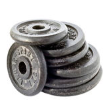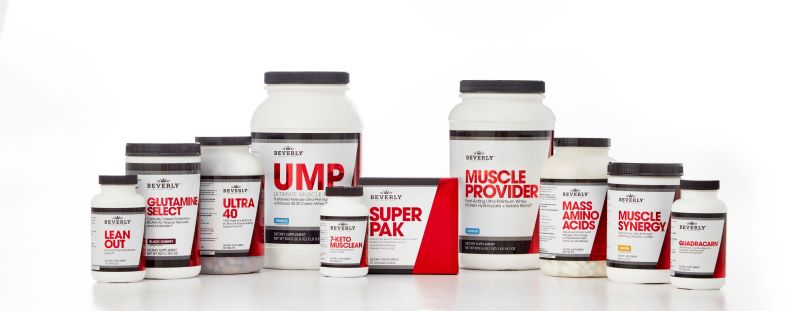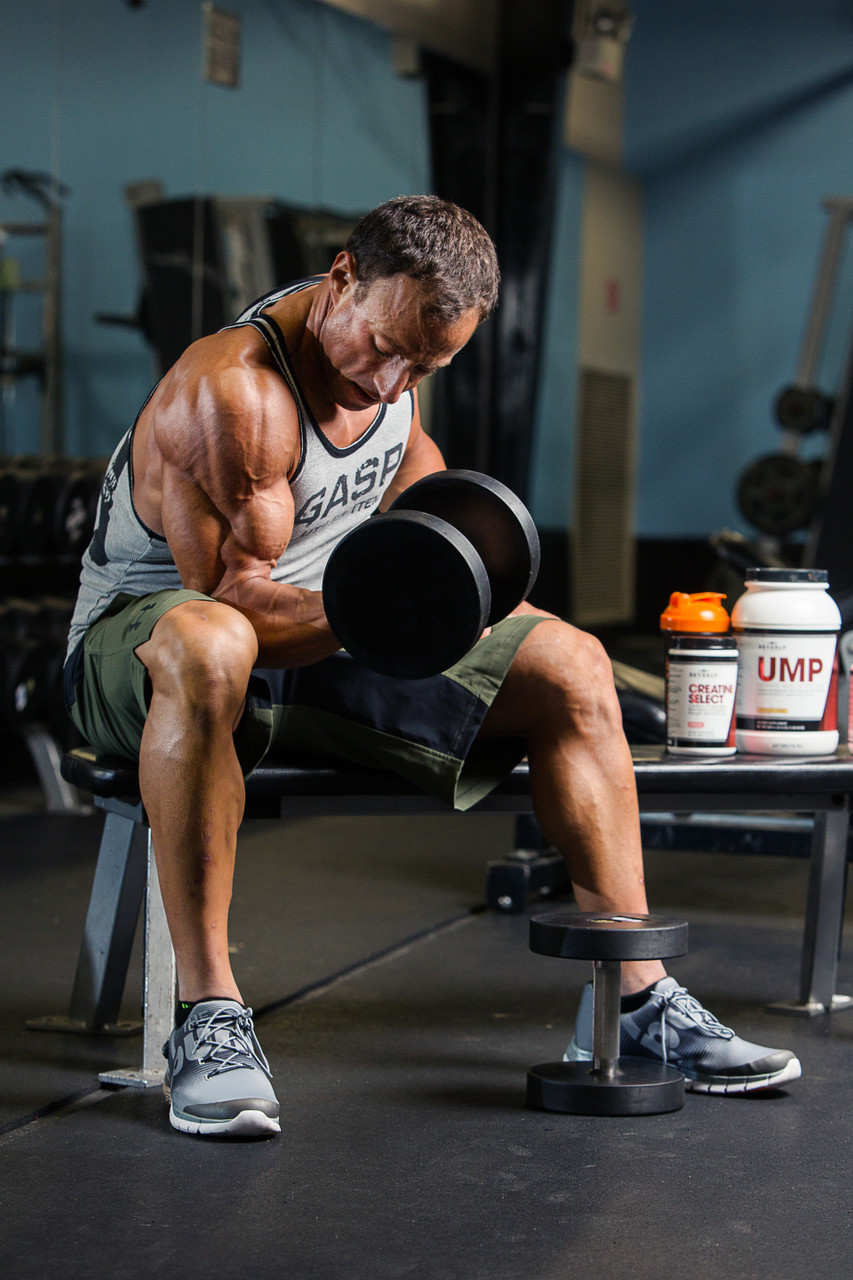Want Bigger Muscles
Expose them to Bigger Workloads
By: Beverly Advisory Team
Four Horsemen
Resistance, sets, reps, and time -these are the “four
horsemen” of resistance exercise that act in combination to determine the
workload placed on your muscles during your workouts. To make your muscles
bigger, you must expose them to bigger workloads over time.
This concept is known as PROGRESSIVE OVERLOAD (PO). In this article, we”ll tell
you how to use the four horsemen to achieve PO when lifting weights and during
cardio. We”ll also reveal the important relationship between PO and supplements.
More productive workouts are just minutes away!
Introduction
We see it all the time at the gym: Men and women lifting the same weights for
the same number of sets and reps, their muscles never really changing in
appearance.
Not that there”s anything wrong with that. If you”re happy
with your physique, then keep doing what you”re doing. But if you want your
muscles to get bigger, there”s only one way to make it happen, and that”s with
progressive overload (PO). (NOTE: PO is also essential if you want to improve
your cardiovascular performance.)
PO: To get bigger, your muscles must perform more work over
time
PO isn't something you hear a lot about these days. It”s not
sexy or exciting. It won”t draw clicks like a headline about “1-Minute
Workouts” or the latest celebrity spotting at Soul Cycle will. Yet without PO,
your muscles will not continue to grow. It is the single most important
body-building concept. How to successfully apply it is the focus of this
article.
“Four Horsemen” of
Resistance Exercise
When a muscle generates force over a distance, it is
performing work. Consider the barbell squat exercise. As you stand up from the
squatting (knees-bent) position, your thigh muscles must generate enough force
to overcome the resistance provided by the barbell and your body. To build your
thigh muscles, you need to progressively increase this workload. This can be
achieved by manipulating one or more of the “four horsemen” of resistance
exercise:
1. Resistance
2. Sets
3. Reps
4. Time
Why do so many of us overlook PO in the first place? Perhaps
the main reason is that, at least in the beginning, you can get away with it.
When you first start lifting weights, it doesn’t take much
to stimulate your muscles to grow. Merely going to the gym and performing a
structured workout provides them with a substantial increase in workload
relative to what they are used to. They soon adapt by becoming bigger and
stronger. These “newbie gains” are obvious enough that you find yourself
choosing heavier weights and performing more sets and reps. This leads to
further gains, and so on. That’s PO in action.
Eventually, of course, your gains slow down or come to a
stop. This is natural. The increases in muscle size and strength become less
and less obvious, which makes it easy to fall into what we refer to as the
“sameness trap” of performing the same workload over and over again. The
solution?
You’ve got to pay closer attention to PO. Next, we tell you
how. Remember that workload is always an approximation.
Before we get into specifics, it’s important to realize that
PO is far from an exact concept. The four horsemen -resistance, sets, reps, and
time- act in concert to determine the workload placed on your muscles in a
manner that is anything but easy to measure. Think about your last chest
workout. Did it stimulate your chest muscles sufficiently to increase in size,
or was it merely enough to maintain their current size? How about the last time
you ran on the treadmill? Did your cardiovascular system sustain a greater
workload compared to the run before that? In both cases, the answer is that you
can never know for sure.
It would be great if there were a “magic wand” that you
could wave over your muscles and it would tell you if you overloaded them
sufficiently or not to achieve your desired goal. A device like this would
revolutionize body-building training as we know it. In the meantime, all you
can do is count your four horsemen as closely as possible. Doing so will give
you an approximate idea of the size of the workload placed on your muscles from
one workout to the next. In turn, this will increase your odds of achieving PO.
Record, record, record
All of which brings us to the importance of recording your
workouts. Unless you have a photographic memory -and most people don’t- it will
be very difficult for you to remember the resistance, sets, reps, and time for
every exercise that you perform. This is why you should record each.
Use whichever method you are most likely to stick with,
whether it be a pen and pad of paper, your phone (assisted perhaps by a
suitable app), or otherwise. If you take the pen and paper route, don’t worry
about looking funny at the gym. Most people frankly don’t care what you’re
doing and if they happen to see you writing your workout down, they’ll just
think you’re serious about your training.
Tip: While fitness wearables for resistance exercise
are still in the early stages of development, there are numerous products
available that make it easier to record your cardio workouts. Fitbit is
probably the best-known of these.
Tip: There are many apps for recording resistance
exercise workouts. For example, Fitnotes and Progression have enjoyed some good
reviews. Check them out.

1. Increase the resistance.
Whether you favor 20 reps or 10, 5 sets or 25, free weights
or machines, you should gradually increase the amount of weight you lift. This
will increase the likelihood of achieving PO and stimulating your muscles to
grow.
Let’s be clear: No one is expecting you to lift more weight
at every workout. That would be impossible. There will be up days and down
days, and days where you feel like you’re barely maintaining. This is natural
and inevitable. Also, with the passage of time your muscles will tend to
decrease in size and strength, particularly in the second half of your life.
Proper application of PO will help you mitigate this age-related process
considerably.
Tip: Each week set a goal of lifting more weight in at
least 2 exercises. For instance, this week you might choose the flat bench
press and lying leg curl. The next week it could be squats and bent-over rows.
Tip: You can effectively increase the resistance during
cardio by raising the incline of the treadmill or the speed of the stepmill.
You can also take two steps at a time on the stepmill, but be careful! We’ve
even seen some daring folks hold a dumbbell or a barbell plate in each hand
while on the stepmill and treadmill. Again, be careful when doing this.
2. Increase your reps
Traditionally, resistance is increased once the top end of a
desired rep range has been reached. For instance, if the desired range is 8-12
reps, then once you achieve 12 reps with a given weight, you will add enough
weight to bring the reps down to 8 and repeat the process.
Tip: Experiment with a wider rep range, such as 8-15.
Once you can lift a given weight for 15 reps, increase the weight sufficiently
to bring the reps down to 8 and repeat the process. The benefit of a wider rep
range is that it exposes your muscles to different levels of resistance.
Essentially, with an 8-15 rep range, you are getting the benefits of training
with “low” (8), “medium” (10-12), and “high” (15) reps in a cyclical fashion.
3. Increase your sets.
Holding everything else constant, if you increase the number
of sets performed for a given muscle group, you will achieve PO. For instance,
if you typically do an average of 10 sets for your back and you increase this
number to 15, you will have increased the workload. As with reps and
resistance, you can’t increase your sets to infinity. Through trial and error,
many bodybuilders have found that beyond about 20 sets per muscle group, the
returns sharply diminish. It’s then that you have to turn to other methods of
achieving PO.
Tip: Set a goal of increasing the total number of sets
performed for each major muscle group by 2 each month. To illustrate, let’s say
you are currently doing a total of 10 sets for back. Here’s how this would play
out over 4 months:
Month 1: 12 sets
Month 2: 14 sets
Month 3: 16 sets
Month 4: 18 sets
Once you reach 20 sets, you can stop and focus on the other
3 horsemen.
Tip: If you do high-intensity interval training (HIIT),
increase the number of intervals (“sets”) over time. This will PO your
cardiovascular system, resulting in improved performance.
4. Pay attention to TIME!
There’s more to increasing the size of your muscles than
making them perform more work. Another critical component of the workload is
the speed at which work is performed, also known as “work rate” or “power”.
Work rate is a function of time, and time is probably the most overlooked of
the four horsemen
One of the reasons the “1 set to failure” approach generally
isn’t all that popular with bodybuilders is that building muscles seems to
require that you sustain a high work rate. One set just doesn’t cut it,
especially if you are an intermediate or advanced lifter. This explains why bodybuilders
tend to prefer higher-volume workouts (i.e. more sets and reps) and relatively
brief rest periods between sets. (The longer you rest between sets, the lower
your work rate.) The work-rate hypothesis also helps explain why moderate loads
(e.g. 8-15 reps) tend to build muscle better than lighter or heavier loads.
One of the most effective ways of achieving PO is increasing
the amount of work performed in a fixed amount of time. For instance, let’s say
you devote 45 minutes to training chest. If you normally rest, say, 1 minute
between sets, gradually cut it down to 45 seconds. After 8 weeks of this, cut
it down to 30 seconds.
Of course, as you reduce your rest periods, you’ll likely
have to reduce the weight and/or reps. This is where things get a little
unclear: Are you actually achieving PO if you train faster but lift lighter
weights? Again, you can never know for sure. All you can do is experiment and
see. As a general rule of thumb, if it feels like your muscles are working
harder, they probably are.You can also increase the workload by performing your reps
faster (explosively), though this may increase your risk of injury.
Tip: “Time loading” works especially well for
body-weight-only exercises such as push-ups and squats. For instance, do as many
push-ups as you can in 1 minute. Let’s say you complete 20 push-ups before
being unable to complete another. Now rest 5-10 seconds and do some more. Keep
doing this until 1 minute has passed. Let’s say you complete a total of 40
push-ups. Next time you do push-ups, try to beat this number. Every month,
increase the time interval by 30 seconds and continue doing as many push-ups as
you can until you reach 4 minutes. This may sound easy, but it’s actually very
tough if you’re doing strict push-ups!
Tip: If you’re a cardio junkie, invest in a Fitbit or a
comparable fitness wearable. Increase the number of steps you perform daily
over a period of weeks. For instance, if you start off with 2000 steps daily,
bump this up to an average of 3000 steps daily over the next 2 weeks. On
weekends, shoot for 10,000 steps daily!
Tip: Do calorie-burn warm-ups. Here’s how it works.
Burn as many calories as you can in 5 minutes using your choice of cardio
equipment. Each month, add 1 minute and continue increasing your calorie-burn
figure.
Supplementation
Does the overload principle apply to supplementation?
Totally. Think about it: Doesn’t it makes sense that as you push your body to
handle greater workloads, you might benefit from a more comprehensive
supplementation regime?
Whereas a simple quality protein powder like Muscle Provider or Ultimate Muscle Protein can be enough during the early stages of training,
as it becomes more difficult to achieve PO and stimulate gains, you may want to
begin stacking a wider range of supplements. Recovery, stamina, nutrition
–these and other factors can limit the rate at which you progress.
Tip: Check out the stacking section of the new Beverly
catalog. There you will find stacks to suit a variety of goals, levels of
experience (beginner through advanced), and budget.
Tip: Some of the techniques outlined above for
achieving PO can really test your stamina. For a natural stamina booster, try Ultra 40 Argentine beef liver tablets. Start with 6 tablets daily (2 each at
breakfast, lunch, and dinner), and each week add 1 more tablet per meal until
you reach 18 tablets daily.
Tip: The most important muscle-building nutrient is
protein. The building blocks of protein are amino acids. If you”re used to
getting all of your protein needs at meals, try supplementing your diet with
amino acids in between meals. It might provide the extra muscle-building boost
you need. Mass Amino Acids, Density and Muscle Mass work well for this purpose.

